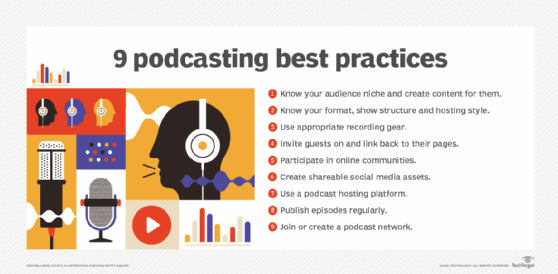What is podcasting?
Podcasting is the preparation and distribution of digital audio files to the computers of subscribed users using Really Simple Syndication (RSS) feeds. These files, made available on the internet, may then be uploaded to streaming services, which users can listen to on their smartphones, tablet devices or other kinds of multimedia players.
The word podcast may refer to a specific audio show or individual episodes of that show. Podcasts are typically available as a series of prerecorded talk-radio show episodes that users can listen to on demand from a mobile device. Podcasters often publish episodes on a regular schedule.
There is no prescribed format, length or style for a podcast. The cultural milieu around podcasting is sometimes referred to as the podosphere, in the same way the cultural environment of blogging is called the blogosphere. Podcasts are sometimes referred to as a digitally disruptive format because they changed how consumers access content. They also changed how advertisers monetized it. Today, podcasting is a valuable way to reach niche markets and gain a digital following.
Who creates and listens to podcasts?
Content producers have increasingly turned to podcasts as an inexpensive and user-friendly distribution channel to reach a large audience of digital natives and consumers of internet content. Musicians and bloggers were early adopters of podcasts. Over the years, many mainstream media organizations, such as The New York Times, National Public Radio and The Washington Post, have since adopted the format, as have individual thought leaders, business and life coaches, actors, entrepreneurs, sports commentators, spiritual guides and more.
Some devices, like Apple iPhones, come with a preinstalled podcast directory. A podcast directory is an application that listeners can use to search for, store and listen to podcasts. Users can select any podcast via the directory. Many podcasts are free to download and listen to through the Apple Podcasts -- formerly iTunes -- application. Some podcasts are associated with websites to provide additional resources and community forums for fans.
In addition to Apple Podcasts, some popular podcasting applications or directories are the following:
- YouTube Music.
- Amazon Music.
- Spotify.
- Overcast.
- Audible.
- Pocket Casts.
- TuneIn Radio.
- iHeartRadio.
- Pandora.

What is videocasting?
Many podcasters stick to the traditional podcasting format, i.e., audio only. However, many have also adopted videocasts, which refer to podcasts with video elements. The element can be a full recording of the podcaster and any guests or something simple, like an image of the podcast's cover art.
There are many reasons podcasters adopt videocasting:
- To reach a wider audience via video content-sharing platforms, like YouTube, Twitch or Vimeo.
- To connect with internet users who prefer video content over audio-only content.
- To increase engagement with existing listeners.
Video podcasting is also known as vodcasting.
How does podcasting work?
Podcasts are digital audio content distributed over the internet using a podcast hosting service or platform. Some examples of podcast hosting platforms are the following:
- Buzzsprout.
- Podbean.
- Simplecast.
- Spreaker.
- Blubrry.
- Castos.
- Transistor.
- Captivate.
These services store all podcast episodes in one location and automate the generation of RSS feeds. These feeds list all the podcaster's episodes and make the episodes available to listeners, usually via a podcasting app, like Spotify or Apple Podcasts, or via the creator's website. Listeners can subscribe to a particular RSS feed in their preferred app to automatically receive new episodes of selected podcasts.
When listeners subscribe to a podcast, their RSS feed automatically updates their device with new episodes. Podcasts may also be uploaded directly to platforms such as Patreon's, SoundCloud's or YouTube's streaming services or registered with a content aggregator, like AllTop or Feedly, which add podcasts to their directories.
How to create a podcast
Podcast production is not complex. Podcasts are generally audio files, but the same process can be used to prepare and share image, text and video files. A podcaster can save their digital audio files as MP3s and upload the MP3s to the hosting platform of their choice. The MP3 file has its URL inserted into an RSS Extensible Markup Language document as an enclosure within an XML tag.
The following podcasting equipment and components are needed to create a podcast and record an audio file:
- Podcast microphone. USB microphones are relatively cheap and easy to use. The built-in microphone on a laptop or smartphone also works. A professional-quality recording mic should be considered if high audio quality is the goal.
- Recording application. Many devices come with free audio recording applications, such as Apple's Voice Memos app, to record and save audio. Audacity is free audio recording software that works on desktop operating systems, like Microsoft Windows, Apple macOS and Linux. Recording applications may have editing software and enable exporting of audio files.
- Hosting site. Once recorded, a podcast can be distributed using a podcast distribution platform.
Here are the nine steps to record a podcast using a computer and a USB microphone:
- Plug the microphone into the computer's USB port.
- If not already installed, install a digital audio application, like GarageBand on Apple devices or the Voice Recorder app on Windows 10 machines.
- Open the program, and set the audio input to recognize the audio from the microphone.
- Test the microphone to ensure the levels are appropriate and respond to audio in the room.
- Press the record button, and speak to start recording the intro.
- If necessary, edit the podcast afterward using the digital audio program's built-in tools or an external application, like Adobe Audition.
- Export the audio file using the program's export function.
- Upload the audio file to an audio sharing or podcast-specific platform.
- Share the link to the published podcast on social media and elsewhere to attract listeners.
What are the benefits of podcasting?
Podcasting has many benefits for podcasters and listeners:
- Easy to create. All it takes to make a podcast is a microphone, audio software, a computer and an internet connection. No additional knowledge or equipment is needed. One simple way to create a podcast is to speak into the voice notes app on a smartphone.
- Easy to distribute. Podcasts can be uploaded and made available to listeners using a free YouTube or SoundCloud account. Any service or device that can host an audio file can host a podcast.
- Regulation-free. There are no Federal Communications Commission or other government regulations to control how podcasts are created or distributed. This enables a level of free speech that is often not possible on more established platforms, like television and radio. At the same time, podcasters are allowed to copyright their work, just like other traditional content creators, like broadcasters, writers or artists.
- Long form. Podcasts can be of any length. The long-form structure enables a more in-depth treatment of topics that is often not possible with other media, where the focus is more on "snackable" content.
- Informative. Podcasts can be created around any topic and can usually find an audience interested in that topic, no matter how offbeat or niche it may be.
- On-demand access. Users can access and listen to a podcast at any time on their mobile devices. Podcasts are also easy to listen to while doing other things, like working, driving, exercising, cooking or cleaning.
- Valuable marketing and advertising tool. The most popular podcasts help marketers reach their audiences. They are an effective multichannel marketing tool because they provide helpful information without always trying to sell something. Podcasts can also be a touchpoint along a buyer's journey, offer good backlinking opportunities and enable brands to refine their search engine optimization strategy.

The history of podcasting
Podcasting has existed since the 1980s. In its earliest days, it was called audio blogging. People would record their pieces and share the audio content over the internet, like auditory blog posts. In 2004, British broadcaster Ben Hammersley first used the term podcast to describe this new type of content. The term combined the words iPod and broadcast.
The growth of podcasts took off in the mid-2000s as internet and broadband use exploded worldwide. In 2004, former MTV video jockey Adam Curry and software developer Dave Winer wrote iPodder Lemon -- now called Juice -- a cross-platform podcast receiver application that lets users listen to internet audio programs at any time and from any compatible device. Curry has been the host and co-host of several podcasts. He is referred to as the "Podfather" for his role in popularizing the podcast medium. One of his first podcasts was Daily Source Code, intended for an audience interested in technology.
In 2019, Spotify acquired Gimlet Media and Anchor, two prominent podcast hosting platforms. That was the start of the streaming platform's interest in the format. That same year, Edison Research issued the "The Podcast Consumer" report, which stated that 90 million people in the U.S. had listened to podcasts in one month. The format has continued to grow in popularity in the corporate and consumer sectors. Per the latest report, published in 2024, more people than ever are listening to podcasts, with 67% of the 12-plus population in the U.S. having listened to a podcast.
The report also found that monthly podcast listeners include 59% of listeners aged 12-34 and 55% of those aged 35-54. These figures demonstrate the huge potential for podcasters and digital advertisers to reach and connect with key audiences via the podcasting medium.
Learn digital marketing best practices businesses should follow to incorporate new mediums, like podcasts.







